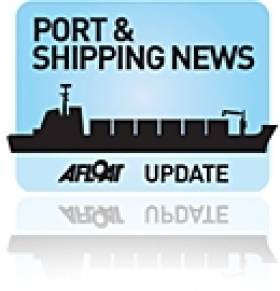Displaying items by tag: Animal Feed
Ship Snapshot: Bulker From Black Sea Berths With Animal Feed In Warrenpoint Port
#Ports&Shipping - A Panamanian flagged bulk-carrier loaded with 18,000 tonnes of animal feed arrived in Warrenpoint Port, Co. Down following a voyage from a Black Sea port in Romania, writes Jehan Ashmore.
The bulker, Fanaria according to Warrenpoint Port was assisted onto its berth using two tugs on 11 September. Afloat has identified the tug at the stern as Mourne Shore, the veteran vessel dating to 1964 was formerly the German serving Bugsier 29. Working the mooring lines at the bulker's bow is understood to be the tug's fleetmate, Mourne Valley.
Warrenpoint Port which is Northern Ireland's second largest port including Seatruck's ro-ro freight services to Heysham, England. In addition to handling containers, dry-bulk and break-bulk cargoes. The port as previously reported this month, announced a new proposal for dredging operations in Carlingford Lough.
The port sought views and comments from the public and key stakeholders on the proposed changes to how dredged material from the harbour is dealt with. A public consultation was scheduled to have taken place this day last week at Warrenpoint Town Hall.
On the southern shores of Carlingford Lough is Greenore Port, Ireland's only privately operated port. Last year saw the launch of the first ever car-ferry service on the cross-border lough linking the Co. Louth port with Greencastle in Co. Down.
Largest Cargoship to Drogheda Port Calls On The Boyne
#LargestShip - The largest ever cargoship to dock at Drogheda Port berthed at the Co. Louth's downriver terminal at Tom Roes Point.
The MV Botnia arrived on 20 January from Klaipeda in Lithuania. The vessel having taken a seven day sea voyage with a cargo of 5,500 tonnes of animal feed for Cefetra Limited.
Drogheda has been building considerable trading links with Klaipeda over the past few years with regular calls increasing each year. It is one of the few ice-free ports in northernmost Europe and has a throughput volume larger than any port in Ireland.
The Botnia is registered in Antigua and Barbuda and has a deadweight carrying capacity of 8,300 tonnes.
The previous largest vessel was the MV ‘Arklow Bridge’ in 2012 with a deadweight carrying capacity 7,175 tonnes.
Botnia at 121m in length was assisted by the tug Mourne Pride which was dispatched from Greenore Port and the workboat tender Boyne Protector.
Irish Ports Witness Surge in Animal Feed Imports
#FodderShipments – As Irish Farmers struggle with one of the worst fodder crisis in over 50 years, ports across the country have seen unprecedented levels of animal feed imports, according to the Irish Maritime Development Office (IMDO).
Most of the State's ports have seen notable throughput increases since the third quarter of 2012, after a poor summer period for farmers. The IMDO noted that the first quarter of 2013 saw volumes of animal feed increase by over 80% in terms of bulk shipments, on the corresponding period last year.
In the recently published Irish Maritime Transport Economist, the IMDO reported substantial annual growth in animal feed imports, which increased by 34% during 2012.
A number of farming interest groups have come together to support the importation of animal feed from the UK and France in recent months, resulting in increased activity on Irish Sea ferry services, particularly over the last three weeks.
The IFA sourced the first consignment of hay from France which arrived at Rosslare Europort on the 9 May aboard the ro-pax ferry Celtic Horizon.
During this month's bank holiday, ports also recorded increased fodder imports from bulk shipments.
The western and northern parts of the country appear most severely impacted and it is anticipated that fodder will continue to steadily arrive at Irish ports for the foreseeable future.































































